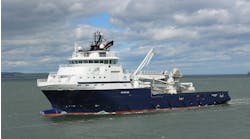Expanding territories
The envelope of available territory accessible to the drillbit is about to expand again. In the most recent years, expanding the drillable envelope was accomplished by new technology – 3D seismic, high capacity semis, and deep-drilling technologies.
This technology capability envelope has now pushed beyond the exclusive economic zone (EEZ) limits of most coastal nations and put the deepwater reaches of the oceans into play for oil exploration. To date, no oil company has tested the legality of drilling in unclaimed international waters. But, vessels like the Joides Resolution continue to conduct international research programs using consortia to fund coring and drilling operations in very remote oceans.
The United Nation's Law of the Sea set the EEZ limits of coastal nations at 200 nautical miles from their shores, but the continental shelves extend farther offshore in many areas. It is these regions that are now in play.
Coastal nations are mapping the outer reaches of their continental shelves before claiming exclusive economic zone (EEZ) extensions. Image modified after Science.
null
According to a recent Science article, up to 60 nations could benefit from expanded EEZs. For example, New Zealand could add as much as 2 million sq km of new territory. Russia has claimed half of the Arctic Ocean and has applied for 1 million sq km of added EEZ. India could claim up to an additional 1 million sq km because of the Indus delta fan. The US could claim as much as 750,000 sq km in three oceans with most of the new acreage in the Atlantic Basin.
The claims process has just begun and countries have ten years to define their continental shelf boundaries once they have signed the convention. Applications for territorial extensions must be by 2009 or countries lose the control of any new territory. There is still plenty of time to set your sights for the outer limits and plan for the newest deepwater drilling frontiers.
Seabed research
Ocean Drilling Program (ODP) Leg 205 continued the placement of long-term monitoring stations with the installation of two new boreholes off the Pacific coast of Costa Rica. The CORKs (circulation ovviation retrofit kits) were installed in two sites: one in a seafloor trench and the other about 500 m away on the continental margin.
The installation of observatories in uncased deep ocean floor boreholes will help to better understand variations of processes within the ocean floor and provide insight into the physical properties of sediments and oceanic crust.
The new CORKs will sample fluids and gases and monitor temperature and pressure in the subsurface over the next two years as part of a ten-year observation program. By studying the plate boundary ODP hopes to better understand the processes that control and are associated with earthquakes and tsunamis in the region. ODP has installed 18 CORKs to date in the world's oceans.
Vessel loss
Rarely does the marine seismic industry lose a vessel. According to CGG, on Dec. 20, 2002, off the coast of Trinidad the seismic vessel CGG Mistral experienced a fire that spread and engulfed the vessel. Fortunately, the crew was safely evacuated. Once the crew was secure, the ship was moved away from any sensitive ecological areas. The fire could not be controlled, and the vessel sank in 750 m of water the following morning.
The CGG Mistral sank after catching fire off the coast of Trinidad. The crew was safely evacuated.
null
The CGG Mistral had recently been upgraded to expand its 3D capability from six to 10 streamers. Widened seismic decks, new engines, and an expanded data room were included in the ship's refit.
TECHNOLOGY
Internet dataroom
Petris Technology has launched Version 3.0 of PetrisWINDS Internet Data Room (IDR). The software is flexible so that users can build their own online IDR in as little as one day. The new version uses ARC/IMS map server from Environmental Systems Research Institute and can link to a variety of other products and analytical tools so that information can be uploaded, managed, and presented online. Multiple levels of security provide access to all or selected parts of the IDR by appropriate users.
Faster processing
SGI says its new Altix 3000 family of servers and superclusters topped the competition in a series of high-performance system benchmarks. The new systems combine SGI's supercomputing architecture with Intel Itanium 2 processors and the Linux operating system.
In recent floating-point tests, a 1GHz Altix 3000 system generated a record performance for a 64-processor server with a score of 862, SGI reports. The closest 64-processor single system image competitor had a score of 267.
SGI says the system also surpassed other servers on a memory bandwidth performance test. The 64-processor system achieved memory bandwidth of 125 GB per second on a single system image. The system demonstrated sustained I/O throughput of more than 2GB per second running a single copy of Linux.





